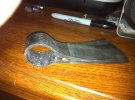- Joined
- Dec 4, 2001
- Messages
- 3,824
Having some issues with a hawk I just forged. Two hawks actually. One I did with some pretty cruddy wrought iron that I had to repair before even welding the bit in. The other I decided to try mild steel as WI is getting hard to find.
The one with wrought iron welded fine, and I used a chunk of O-1 for the bit, but after quenching the bit cracked down the middle of the O-1 piece. Hawk was normalized and cycled and annealed in my oven according to O-1 heat treat specs. Only thing I can think of is the O-1 is the culprit, I've done this with 5160 bits before with no issue.
The one with the mild steel is the real issue. I thought after forging that it was good, one of my best hawks so far, eye was nice and wide, proper taper to the blade, nice form, in other words well pleased with the shape and design. Well I used mild steel flat bar and preformed it, then folded and added a forge tapered piece of road grader blade for the cutting bit and it runs nearly to the eye. The road grader blade I forged the bit out of acts a lot like 1084, but really have no idea what it is, maybe a 1070 steel. Anyway while grinding the scale off after heat treat I noticed part of the edge had a flaw in it. So I decided to put a cheap handle in it and just use it around the place for testing and see how it works. I put the handle in and it was OK fit, but got to tightening it up with a hammer and it started to separate at the eye welds. Tapped some more and it split fairly easily and spread out. Looks like some of the mild steel welded, but other area's are dark and look like cold shuts. Now I didn't grind the surfaces before welding, possibly that would help. Hawk was cycled and heat treated in my oven, I used 1084 specs as a guess for the bit steel and it holds and edge and is tough.
Is there something in mild steel's alloy that doesn't like to bond to itself or high carbon steel? Or did I just need to be hotter? I've welded wrought iron together before with no issues like this.
Thanks
The one with wrought iron welded fine, and I used a chunk of O-1 for the bit, but after quenching the bit cracked down the middle of the O-1 piece. Hawk was normalized and cycled and annealed in my oven according to O-1 heat treat specs. Only thing I can think of is the O-1 is the culprit, I've done this with 5160 bits before with no issue.
The one with the mild steel is the real issue. I thought after forging that it was good, one of my best hawks so far, eye was nice and wide, proper taper to the blade, nice form, in other words well pleased with the shape and design. Well I used mild steel flat bar and preformed it, then folded and added a forge tapered piece of road grader blade for the cutting bit and it runs nearly to the eye. The road grader blade I forged the bit out of acts a lot like 1084, but really have no idea what it is, maybe a 1070 steel. Anyway while grinding the scale off after heat treat I noticed part of the edge had a flaw in it. So I decided to put a cheap handle in it and just use it around the place for testing and see how it works. I put the handle in and it was OK fit, but got to tightening it up with a hammer and it started to separate at the eye welds. Tapped some more and it split fairly easily and spread out. Looks like some of the mild steel welded, but other area's are dark and look like cold shuts. Now I didn't grind the surfaces before welding, possibly that would help. Hawk was cycled and heat treated in my oven, I used 1084 specs as a guess for the bit steel and it holds and edge and is tough.
Is there something in mild steel's alloy that doesn't like to bond to itself or high carbon steel? Or did I just need to be hotter? I've welded wrought iron together before with no issues like this.
Thanks

